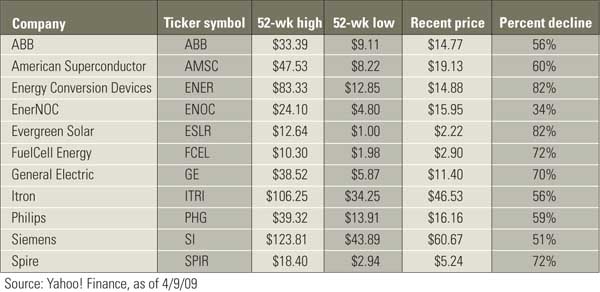Let’s Stop Bailing Out on Alternative Energy
Investors are continuing to bail out of alternative energy stocks—good, promising companies such as ABB, American Superconductor, Evergreen Solar, and Itron. These companies and many like them were Wall Street darlings not that long ago. Not anymore.
As shown in the share prices of a sample of publicly held energy-tech companies (see table), the average 2008 to 2009 decline of these stocks is now at 63%—dwarfing even the severely depressed Standard & Poor’s Index (down 41%) and the Dow Jones Industrial Average (down 39% from its 52-week high as this article is written).

One reason for the deterioration of energy-tech stocks is that traders have historically abandoned alternative and renewable energy shares when energy prices are falling. And that’s the bailout we don’t need. It is, to paraphrase former Federal Reserve Chairman Alan Greenspan, “irrational pessimism.” The bears are ravishing the market.
Turning around the bear market in alternative energy stocks will be hard to do. In-and-out traders don’t pay much attention to the promise or the details of emerging technologies that have the potential to combat our energy problems. They only care about the profit or loss of their last trade and prospects for their next trade.
Traders don’t think much about the gas lines of the mid-1970s, the global effect both Gulf wars had on energy prices, or the oil price spike to $147 a barrel in summer 2008. But longer-term investors in alternative energy should care a great deal about those seminal events. When similar energy market conditions re-emerge in the years ahead, those investors could be positioned for a big win.
To help investors make the decision to bet on a new generation of energy technologies, alternative and renewable energy developers, producers, and proponents have to do much more than just promise relief some time in the distant future. When energy markets are distressed, as they are now, alternative energy proponents must spend more time and effort delivering persuasive, factual messages about near-term advantages and longer-range potential to investors and the general public. Perhaps most importantly, they must clearly demonstrate measurable results.
Promise Versus Practicality
Results of the deployment of alternative energy technologies to date have been hard to demonstrate. Alternative energy has been largely about potential and much less about immediate practicality, with understandable concerns about costs versus coal, gas, hydro, and nuclear. Solar power continues to be inefficient. Wind power is erratic—capable of producing abundant, cleaner power when and where it can, but rarely when and where it’s needed. Fuel cells don’t easily scale up. As for biomass, ethanol has proved to be far from carbon neutral and also presents society with the issue of food versus energy—a choice that usually favors comestibles over combustibles.
But there are paths worth taking to address these alternative-energy problems. Clearer public policy is the place to start. Alternative energy policies have the potential to create jobs and offer many environmental benefits. State and federal governments should stop waffling on how they approach, support, and implement alternative energy strategies, and stress the positives: American jobs and environmental improvements.
One former client of mine engineered and built a major alternative energy–powered facility for a retailer in an eastern state. A committed grant from the location’s state government augmented the project’s economics, but cutting and signing the rebate check took nearly a year longer than promised, contributing to the company missing its revenue forecasts for several consecutive quarters.
Governments must make their strategies and policies clear and guarantee that their word is their bond. That, in turn, will help make alternative energy investments consistently attractive to venture funds, other private equity organizations, and even individuals. Governmental support at all levels—which can stimulate and sustain the private sector’s supply of capital, ideas, technologists, and entrepreneurs—can’t come soon enough.
Unfortunately, there are warning signs that private equity is getting cold feet. According to recent preliminary figures from the Cleantech Group, energy-tech venture capital investments reached a total of $8.4 billion in North America, Europe, China, and India during 2008, but quarter-over-prior-quarter totals are decreasing. The reported decline was 35%, to only $1.7 billion in the final three months of 2008, and reduced levels of inveastment are expected for 2009.
Government Support Needed to Keep Energy-Tech Alive
In spite of this downward trend in energy-tech investments, we are seeing a great deal of new energy technologies penetrating the marketplace or under development—from more efficient photovoltaic and thermal solar panels and production methods to direct-drive wind turbines that require less maintenance, large-capacity energy-storage systems, and services that can time-shift energy availability.
These and other innovations need more support—from customers who will begin to seriously deploy and support these technologies and from investors who will stay the course when energy costs periodically (but temporarily) decline. In the short term, projected alternative energy investment returns may look poor, but the longer-term advantages are likely around the corner of the next economic upturn.
What should give us all some hope about the future of alternative energy is the installation of new, progressive political administrations in Washington and many state capitals. While the immediate focus is understandably on giving national and local economies a boost, stopping the Wall Street and Main Street meltdown, creating or saving jobs, and restoring confidence in American businesses and investments, better energy policy can help solve many of our most pressing problems.
Steadfast policy and measurable results are the keys to keeping energy-tech innovation and investment flowing. That, in turn, can help create the permanent change in attitudes toward alternative and renewable energy.
–Stuart Pearlman provides strategic communications and investor relations services to energy technology and venture capital firms. His web site is www.PearlmanPR.com.